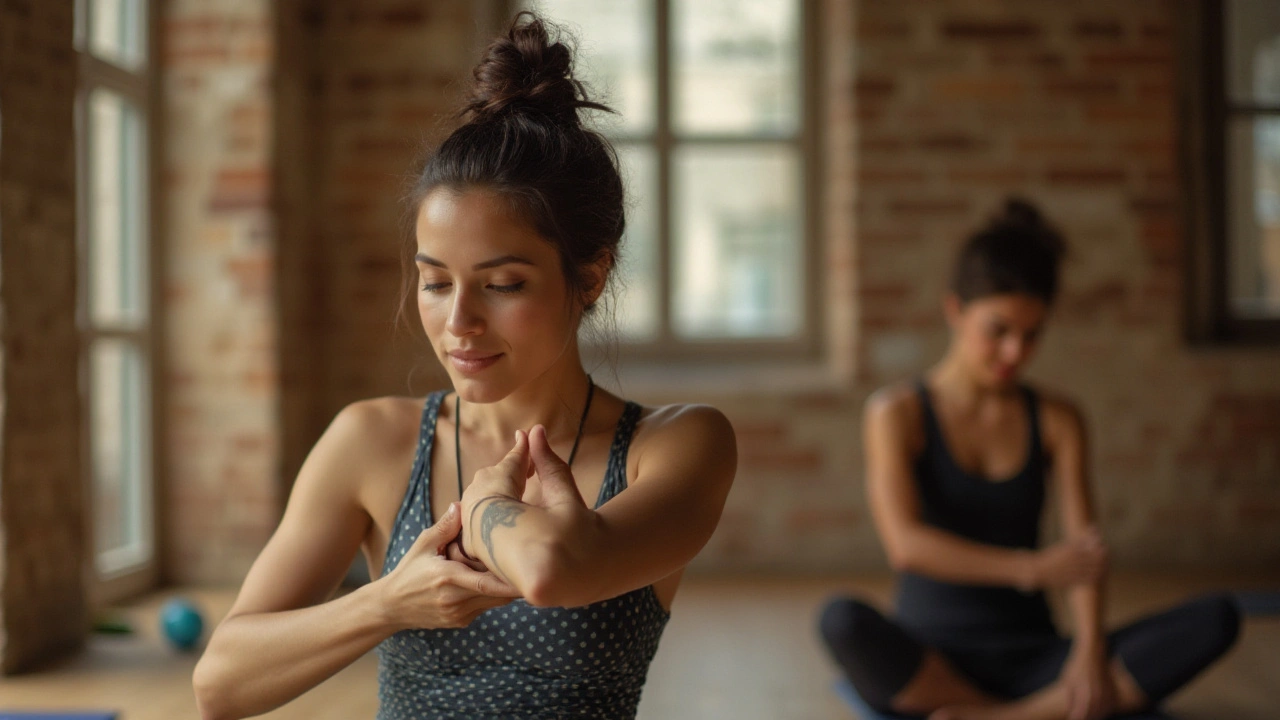Enhance Your Yoga Practice with Fascia Stretching Techniques

Fascia may not get much attention, but this connective tissue plays a vital role in how our bodies move and bend. It wraps around and supports muscles, helping them work together smoothly. When it becomes tight or restricted, it can affect flexibility and comfort during yoga practice.
By incorporating fascia stretching into your yoga routine, you can not only improve your flexibility but also reduce the risk of injuries. Stretching the fascia can lead to better posture and balance, making each pose and movement feel more aligned and natural. Yogis, both beginners and seasoned practitioners, can benefit from exploring how this type of stretching can enhance their practice.
Many folk have found that understanding and stretching their fascia adds a deeper layer of mindfulness and control to their yoga sessions. Whether you're flowing through sun salutations or settling into a quiet meditation, having limber fascia can make your yoga experience richer and more rewarding.
- Understanding Fascia
- The Importance of Fascia Stretching
- Integrating Fascia Stretching in Yoga
- Benefits of Fascia Stretching for Yogis
- Common Fascia Stretching Techniques
- Tips for Effective Fascia Stretching
Understanding Fascia
Fascia is an intricate web of connective tissue that envelops every muscle, bone, nerve, and organ in the body. Imagine it as a continuous sheet, like a full-body suit made of soft yet strong material. Its properties are multi-dimensional, often described as both tensile and elastic, allowing it to support the body's structures while also enabling fluid movement. This tissue is essential in maintaining the body's form and tension, linking the various parts seamlessly together.
This connective tissue has a gel-like composition, rich in collagen, which gives it flexibility and strength. Unlike muscles, which are layered and localized, fascia can be found everywhere, connecting different parts of the body into a single, harmonious whole. It absorbs shock, maintains posture, and offers resistance against physical forces. Despite being such a crucial component, fascia can often be neglected in traditional fitness routines, including yoga, though it plays a significant part in ensuring our physical activities feel smooth and balanced.
Moreover, you may be surprised to discover that fascia is home to a vast network of nerves, integrating deeply with our body's sensory system. This makes it incredibly sensitive to touch, pressure, and temperature changes. Such sensitivity can indicate why fascia becomes tight or restricted, resulting in discomfort or limited mobility. Recent research has shown that fascia not only contributes to physical support but also plays a role in emotional storage, acting as a vessel that holds stress and trauma. This understanding invites a more holistic view of wellness, combining both body and mind.
One of the pioneers in this field, Dr. Robert Schleip, a fascia researcher, asserted,
"Fascia has far-reaching effects on the body's overall functionality and can attribute to both well-being and pain management."His studies illustrate that when the fascia is cared for through appropriate stretching and nurturing exercises, many individuals report enhanced well-being and reduced muscular pain. This highlights the importance of understanding and integrating fascia-focused approaches within physical activities like yoga.
Recent advancements in the study of fascia have also introduced fascinating insights into its adaptive abilities. Fascia has proven to be receptive to various forms of stimuli and can change its structure over time. For yoga practitioners, this is particularly important, as consistent practice integrating fascia stretching can lead to improvements in joint mobility, posture alignment, and even help in the recovery of certain injuries. The adaptability of fascia ensures that consistently stretching it can consequentially aid in overall physical performance.
In conclusion, understanding fascia unlocks a deeper understanding of how interconnected our bodies are. It is a bridge between anatomy and movement, offering insights into the body's miraculous workings. By weaving fascia awareness into yoga practices, we invite a multifaceted approach to wellness that benefits the body as a whole, nurturing not just flexibility and strength but also a healthy mind-body connection.
The Importance of Fascia Stretching
Understanding the role of fascia in our bodies can take a while, but it’s definitely worth it. This connective tissue is like a scaffolding for your body, providing support for muscles and organs. It affects how they work and even how they feel. When fascia is tight, it can cause issues like stiffness and pain, especially during physical activities like yoga. Imagine trying to move smoothly while your body's framework is all knotted up. That’s why stretching it is more important than many realize.
Fascia stretching is not merely about flexibility, though it greatly improves it. It aids in the restoration and maintenance of healthy tissue elasticity. This can be especially beneficial for yogis who aim to deepen their practice. By releasing tension in the fascia, your muscles gain more freedom to stretch. This can lead to noticeably better ease of movement and fluidity in asanas. Another aspect is the role of fascia in circulation. Restricted fascia can impede blood flow, but when stretched, it allows better circulation, which is key to recovery and muscle health.
Many seasoned practitioners swear by the positive effects it has on their yoga journeys. In fact, Jenny Allwood, a seasoned yoga instructor, once said,
"Once I started incorporating fascia stretching, the way my body responded to poses changed dramatically. It's like unlocking a new potential in your body."This perspective highlights what kind of impact a more flexible fascia can have.
Moreover, the tension held within fascia often accumulates from stress or poor posture. Hence, stretching it can also act as a stress reliever, aiding mental relaxation. An often overlooked benefit is how it can play a role in enhancing proprioception—your body's sense of positioning. By improving this, you gain better control and awareness during yoga, leading to fewer risks of injury. It’s fascinating how an open fascia can reduce strain on your joints, protecting them from overuse or imbalance during workouts.

Integrating Fascia Stretching in Yoga
Incorporating fascia stretching into your yoga practice can transform both the way you feel on your mat and the results you experience off it. Fascia, a connective tissue surrounding your muscles and organs, is like an intricate web, more involved in your movements than you might realize. When you give this often-overlooked system the attention it deserves, you unlock new levels of flexibility and resilience. Many seasoned yoga practitioners have started to realize how integral it is to stretch and loosen up their fascia, leading to deeper and more satisfying poses.
To bring fascia stretching into your yoga practice, start with mindfulness and the focus on what you feel. Yoga sessions already emphasize awareness, and this is a natural extension. Tune into the subtle sensations, those delicate shifts that indicate your fascia is getting the love it needs. During a stretch, hold the pose a bit longer than usual, allowing your fascia full expansion. This prolonged hold aids in releasing tension and hydrating the tissue, which leads to increased flexibility.
“The key is to understand that fascia stretching is more about releasing than forcing,” says renowned yoga expert Thomas Myers, author of Anatomy Trains. “Allow time and gentle movements to facilitate the change.”
Some yoga poses innately integrate fascia stretching. Poses like Downward Facing Dog or the humble Cat-Cow sequence can be flavored with a fascia-friendly approach. Lengthen through the spine, feel each vertebra unwind and visualize the fascia stretching with each breath. These poses, combined with an intent focus on fascia, seem to work wonders for those who practice regularly.
The benefits go beyond flexibility and reach into the realm of injury prevention. When fascia is supple, it allows muscles to glide smoothly, reducing the likelihood of strains or tears. Many athletes have also adopted fascia stretching techniques for these preventative capabilities, finding them invaluable in maintaining their peak physical condition.
For those who cherish the mental side of yoga, fascia stretching can also enhance the meditative aspect of practice. The focused intent required to perceive and influence fascia encourages a deep, inward journey, promoting a profound sense of peace and unity within the body. It engages the mind as much as the body, creating an all-encompassing yoga experience.
Remember that, like any new technique, mastering fascia stretching takes patience and practice. Start slow, and consult with a knowledgeable yoga instructor who understands the complexity of fascia. Their insight could bridge the gap between a good yoga practice and a transformative one.
If science statistics pique your interest, consider this: A recent study on fascia showed that people who consistently integrated fascia-conscious movements into their exercise routines saw a 20% increase in muscle function efficiency. And that's just the beginning of what this approach can offer when added to yoga.
Benefits of Fascia Stretching for Yogis
Fascia stretching opens up a wonderful set of benefits for yogis, enhancing both physical and mental aspects of their practice. For starters, when you engage in fascia stretching, you're assisting your body in releasing tension and increasing flexibility. This is crucial, especially for poses that require deep bends or twists. As the fascia becomes more pliable, movements become more fluid, and the risk of injury is significantly reduced. An interesting fact tapping into the importance of fascia health is that fascia actually contains more sensory nerve endings than muscle tissue, which means their well-being is essential for feeling at ease in our bodies.
Besides physical perks, there's a deeper connection that fascia stretching fosters, helping practitioners cultivate awareness and presence. As a yogi stretches their fascia, a mindful engagement with their body ensues, thereby enabling them to listen to subtle cues and sensations. This kind of bodily awareness often leads to better alignment and posture, providing a foundation for safe and effective practice. Imagine transitioning from Warrior II to Extended Side Angle with ease, sensing the delightful stretch through the legs and side body without discomfort. As Caroline Myss once remarked, "Your biography becomes your biology," highlighting how our physical state is intrinsically linked to our broader self-awareness.
There are also psychological benefits to consider. Engaging in focused fascia stretching can induce a meditative state, which helps in reducing stress and anxiety levels. For many yogis, this relaxation is akin to the serene calm experienced during Savasana at the end of a yoga session. Studies have shown that regular stretching, particularly of the fascia, can promote the release of endorphins, acting as a natural mood enhancer. The body feels lighter, and the mind, more peaceful. Such benefits make fascia stretching an invaluable tool for those looking to deepen their practice holistically, both on and off the mat. In many ways, it acts as a bridge connecting the physical practice of yoga with the mental aspects of meditation and mindfulness.
In essence, incorporating fascia stretching into yoga routines can transform how practitioners move and feel. It's a step towards honoring the connective paths of our bodies, ensuring that as we flow through our series, we do so with grace and health. Beyond enhancing flexibility and reducing injury risk, the practice nurtures a holistic approach to yoga, marrying physical vigor with mindful tranquility. So, next time you're on the mat, remember to give your fascia some much-needed attention. It's a small investment that yields profound returns, enriching your practice and your connection with yourself.

Common Fascia Stretching Techniques
Fascia stretching may sound like a complex term, but it's truly about listening to your body's needs. For those practicing yoga, these stretches can add incredible depth to your routine. One foundational technique involves using gentle, sustained pressure to stretch specific areas. It’s more than just lengthening muscles; this is about easing the fabric of your body to promote smooth movement. Some prefer incorporating props like foam rollers. When rolling, move slowly, allowing the fascia to respond gradually, helping shift stiffness or tension. It’s a simple, yet effective way to target those underlying layers that affect movement and posture.
Another method involves dynamic stretching. These movements are rhythmic and incorporate gentle bouncing to softly coax the connective tissues into greater elasticity. Think of it like waking up your muscles and fascia before diving into more demanding poses. It’s like giving your body a gentle nudge, gently yet firmly encouraging it towards better performance. This type of stretching is especially popular among athletes, as it helps in enhancing range of motion before engaging in physical activity. Many yoga practitioners find this approach particularly beneficial as it warms up the body, making transitions smoother and more controlled.
For those interested in a deeper release, yoga poses specifically aimed at enhancing flexibility and fascia tension can be incredibly beneficial. Poses such as the downward-facing dog or cat-cow stretch not only engage muscle groups but also apply a manageable stress to fascia lines. It’s vital to balance these stretches by integrating them mindfully into your routine, ensuring they complement rather than replace your usual stretches. It's about harmony, allowing each part of your routine to contribute toward a more balanced, resilient body. As one revered yoga teacher once said,
"It's not about touching your toes, it's about what you learn on the way down."Understanding how your body engages with each movement will cultivate a richer, more fulfilling practice.
For those who prefer a more scientific approach, a growing body of research supports the integration of both static and dynamic fascia stretching in yoga. These studies suggest sustained stretching, held over time, can result in lasting flexibility boosts and even decreased pain. Below are some methods and their respective benefits:
- Foam Rolling: Supports the release of tight fascia, reducing discomfort. Ideal before or after yoga sessions.
- Dynamic Movements: Encourages elasticity, increasing range of motion. Practice before starting vigorous poses.
- Prolonged Poses: Holding poses for extended periods aids deep fascia release. Common in Yin Yoga.
Incorporating these fascia-focused stretches into your yoga practice can lead to surprising improvements. Not only does fascia stretching contribute to better flexibility, but it also supports injury prevention and fosters a more harmonious connection with your body. As you explore these techniques, you'll discover how each complements your individual needs, making your yoga journey more rewarding and enriching.
Tips for Effective Fascia Stretching
When considering the role of fascia stretching in your yoga practice, it becomes essential to approach it with thoughtfulness and attention. One crucial tip is to be patient with your body. Fascia, unlike muscle tissue, responds steadily to stretching. Rushing through your fascia stretches might not yield the desired results. Allow your body the time it needs to extend and release. It's a bit like coaxing a bud to bloom—gentle and steady encouragement is key. Whether you're working on a deep forward fold or a relaxing child's pose, keep in mind that fascia responds best to long, sustained stretches.
Another fundamental tip is to focus on your breath during stretches. The breath acts as a guide, encouraging deeper relaxation of the connective tissues. As you inhale deeply, envision your breath reaching the areas needing release; as you exhale, allow your tension to melt away. This synchronization between breath and stretch can transform how your fascia elongates, offering a particular sense of calm to the process. Paying attention to the breath not only fuels the body but also ensures that stress doesn't impede your ability to stretch effectively.
Consistency is also a major player in achieving effective results. Regularly incorporating fascia stretching into your yoga routine can yield significant improvements. Rather than overloading a single session, consider establishing a steady rhythm of practice throughout your week. This consistent approach helps to unlock restrictions slowly and minimizes potential injury. Additionally, it's valuable to understand that every individual is unique—adjust your approach to what feels right for your own body.
Many seasoned instructors recommend using props to support fascia stretching. Items like yoga blocks, straps, or bolsters can provide the assistance needed to deepen your reach safely. Props can enhance your alignment and cultivate more openness in your poses. According to Sarah Powers, a renowned yoga teacher,
"Using props mindfully can transform your practice, allowing you to explore dimensions not easily felt before."So as you prepare for your next yoga sequence, consider how these tools can aid your yoga practice and make fascia stretching a more accessible endeavor.
Finally, listening to your body's feedback is crucial. While stretching, take notice of any discomfort or resistance. Fascia can respond to overstretching with tightness or soreness, so it’s vital to differentiate between a constructive stretch and potential strain. Remember, it's okay to pull back and adjust as necessary. The goal is to encourage elasticity through gentle extension, not to force the body into submission. Embrace these nuances, and you'll find that your practice becomes a harmonious dance of intention and awareness.





